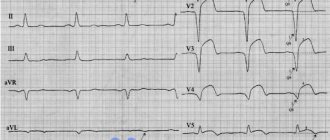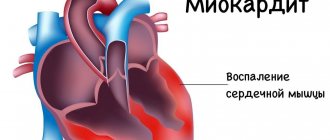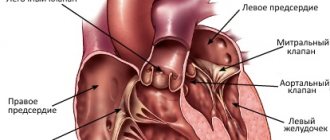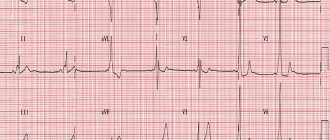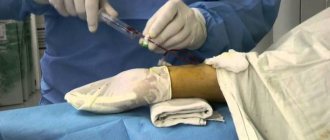Spontaneous kidney rupture
Ultrasound machine HM70A
Expert class at an affordable price.
Monocrystal sensors, full-screen display mode, elastography, 3D/4D in a laptop case. Flexible transformation into a stationary scanner with a cart.
Introduction
Non-traumatic renal rupture, in other words, spontaneous renal rupture, unlike traumatic ruptures, is much less common and in many cases presents diagnostic difficulties [1-3]. In the world literature over the past century and a half since spontaneous renal rupture was identified as an independent pathology, over 1000 observations of spontaneous renal rupture have been published. However, a relatively small number of studies are devoted to studying the mechanisms of occurrence, diagnosis and treatment of spontaneous renal rupture. The main reason for this situation is the rarity of this pathology. Spontaneous renal rupture can be a complication of renal neoplasms, hydronephrosis, renal cysts, observed in periarteritis nodosa, acute pyelonephritis, urolithiasis, aneurysm of the renal arteries, Wegener's granulomatosis, renal infarction, hemorrhagic fever with renal syndrome, etc. Spontaneous kidney rupture may occur in a number of predisposing conditions, such as pregnancy and childbirth. In rare cases, spontaneous renal rupture may occur in an otherwise intact kidney. In turn, spontaneous renal rupture is part of a much larger family of pathological conditions, united in domestic and foreign literature under the general name “spontaneous perirenal bleeding.” Spontaneous perirenal bleeding can also be caused by blood diseases (leukemia, hemophilia, etc.), taking anticoagulants, adrenal rupture, adrenal tumors, aortic aneurysms, etc. [4].
Reviews summarizing cases described in the literature from 1933 to 2002 [5-8] included 448 observation units. The main etiological causes of spontaneous perirenal bleeding are tumors, which, according to various authors, occur with a frequency of 57 to 63% (of which 24-33% are benign and 30-33% are malignant). With a slightly lower frequency of occurrence, the causes of spontaneous renal rupture are vascular diseases (17-26%, of which periarteritis nodosa - 12-13%). The third main cause is infections (4-10%).
Currently, there is no uniform diagnostic and treatment strategy for determining spontaneous renal rupture, the severity and prognosis of this condition, despite the fact that spontaneous renal rupture is an urgent condition and requires immediate action. There are frequent cases of incorrect diagnosis, post-mortem diagnosis of spontaneous renal rupture, and unjustified delay of surgical intervention. At the same time, the increasing sensitivity of diagnostic methods such as ultrasound scanning, multislice computed tomography and magnetic resonance imaging significantly increases the surgeon’s ability to timely and accurately determine the cause of spontaneous renal rupture. Based on these data, in most cases it is possible to identify the cause that caused the kidney rupture, assess the feasibility of surgical intervention, and also plan its volume. We present our own observation when, on the basis of a comprehensive examination, we were able to establish a diagnosis of spontaneous renal rupture and choose a rational treatment tactic.
Clinical observation
The patient, 46 years old, was admitted to the Urological Clinic of the MMA named after. THEM. Sechenov with complaints of weakness, lethargy, fatigue, pain in the lumbar region on the right, palpable formation in the right half of the abdomen.
From the anamnesis it is known that 20 days ago a sharp pain suddenly arose in the lumbar region and lateral abdomen on the right, a rise in body temperature to subfebrile levels, 5 days ago total painless macrohematuria with shapeless clots appeared. It should be noted that the history did not contain direct or indirect indications of previous trauma, previous physical activity, or any surgical interventions. The patient was consulted at our clinic and hospitalized for surgical treatment.
Upon admission, the patient’s condition was satisfactory, the skin was pale and slightly moist. Body temperature has been normal for the last 4 days. In the right hypochondrium, a soft-elastic space-occupying formation up to 110 mm in size, motionless, is palpated. Blood tests showed a decrease in hemoglobin to 9.3 g/l. In urine tests, red blood cells cover the entire field of view. The blood pressure figures correspond to the usual ones (120/80 mm Hg), pulse 80 beats/min. According to the patient, hemodynamic parameters remained stable since the onset of clinical manifestations.
An ultrasound examination in the projection of the middle and lower segments of the right kidney reveals a hyperechoic formation up to 9 cm in diameter, with a clear contour, the integrity of which is compromised. In the perinephric tissue around the tumor there is an accumulation of anechoic fluid in the form of a hematoma (Fig. 1). The left kidney is without pathological changes. Conclusion: The ultrasound picture most likely corresponds to spontaneous rupture of an angiomyolipoma of the right kidney.
Rice. 1.
Ultrasonogram of the right kidney: A - anechoic fluid; B - hyperechoic formation.
Multislice computed tomography revealed that the right kidney was displaced anteriorly and medially by the hematoma. In the middle and lower segments of the kidney, a volumetric formation measuring 69x82x89 mm with tuberous contours, a heterogeneous structure, and areas of fat density predominate. Against the background of adipose tissue, areas of stroma are determined. In the upper sections, a zone of high density (up to 73 units) with uneven contours measuring 50x48 mm is a hematoma. The formation capsule is not clearly visible in several places (rupture?). With contrast enhancement, small vessels are identified in the peripheral regions. Areas of the stroma in the lower parts of the tumor accumulate the contrast agent. The perinephric tissue is tractable; it contains multiple areas of compaction, limited accumulations of fluid, and zones of high density (from 54 to 70 HU). With contrast enhancement, the density of these areas does not change. Streaks extend upward to the lower edge of the liver, downward along the psoas muscle to the level of the iliac vessels. It was concluded that the CT picture (Fig. 2 a-d) corresponds to an angiomyolipoma with hemorrhage into the neoplasm and perinephric tissue.
Rice. 2.
A series of computed tomograms.
a-d)
Angiomyolipomas (arrows - hemorrhage).
After performing multislice computed tomography (MSCT), it was confirmed that the clinical picture was caused by spontaneous rupture, most likely of an angiomyolipoma of the right kidney with hemorrhage into the neoplasm tissue and perinephric fat with the formation of a hematoma. It is necessary to determine the duration of the hemorrhage - whether there are areas of fresh hemorrhages against the background of bleeding into the perinephric tissue, which can determine the indications for emergency surgery. On MRI of the kidneys, the right kidney is displaced and rotated anteriorly (adjacent to the anterior abdominal wall). In its middle and lower segments, a space-occupying formation measuring 90x60x75 mm is detected, with a heterogeneous MR signal (characteristic of adipose tissue, blood in the subacute stage). The MR signal from the perirenal tissue is sharply inhomogeneously changed due to the presence of areas with a signal characteristic of blood in the subacute stage, edematous tissue with a total size of up to 90x75x110 mm. It appears that the renal capsule is ruptured. The MR picture corresponds to a space-occupying formation, most likely an angiomyolipoma, of the right kidney with hemorrhage (in the subacute stage) into the formation and perinephric tissue (Fig. 3).
Rice. 3.
MR tomogram (T2-VI). Tumor of the lower segment with decay and hemorrhage in the subacute stage (arrow).
The data obtained made it possible to exclude the presence of fresh ruptures and hemorrhages and to refuse emergency surgery, which is advisable given the low hemoglobin level in the patient and the planning of organ-preserving surgery. Indications for the latter are due to the presumably benign structure of the tumor, the young age of the patient, as well as her urgent desire to preserve the kidney. Taking into account the large size of the neoplasm and the presence of a hematoma in the perinephric tissue extending to the iliac vessels, the possibility of nephrectomy cannot be ruled out, which is permissible since the function of the opposite kidney is preserved. After 3 days, during which blood and its components were transfused (hemoglobin level was 13 g/l), an organ-preserving operation was performed, the possibility of which was finally established intraoperatively (Fig. 4 a-d).
Rice. 4.
Intraoperative picture of organ-preserving surgery.
a-d)
Stages of the operation.
This observation once again confirms that the size of the tumor does not always determine the possibility or impossibility of performing organ-conserving surgery, since when studying the gross specimen, the diameter of the tumor was 100 mm (Fig. 5).
Rice. 5.
Macroscopic specimen of a kidney tumor.
A)
Macroscopic specimen of a tumor of the right kidney in a block with perinephric tissue and hematoma, with a fragment of renal parenchyma, measuring 100×60 mm.
b)
On the section, the tumor is yellow-brown in color with whitish septa.
A morphological study confirmed that the removed tumor was an angiomyolipoma (Fig. 6).
Rice. 6.
Microscopic specimen of a tumor of the right kidney. Angiomyolipoma. Hematoxylin and eosin staining x 100
Six months after surgical treatment, the patient underwent multislice computed tomography. No pathological changes were detected. Resection area, perinephric tissue without features (Fig. 7).
Rice. 7.
A series of computed tomograms.
a, b)
6 months after surgery.
Discussion
Before the introduction of ultrasound diagnostic methods, approximately 25% of cases of renal angiomyolipoma presented with a sudden onset of pain in the flank or abdomen after spontaneous rupture and subsequent perirenal bleeding. Currently, criteria for ultrasound diagnosis of angiomyolipoma before the occurrence of complications and accompanying clinical symptoms have been developed. The echogenicity of angiomyolipoma on ultrasound depends on the relative content of fat masses in the tumor. Typical angiomyolipoma presents as masses that are hyperechoic compared with the rest of the renal parenchyma; in some cases, there may be an acoustic shadow or, in addition to this, a hypoechoic rim (subcapsular hematoma).
For correct and timely diagnosis of spontaneous kidney rupture or the disease that caused it, the use of modern research methods, such as ultrasound, MSCT, and MRI is required. First of all, screening methods are prescribed - ultrasound diagnostics, which allows you to quickly and confidently diagnose spontaneous renal rupture and carry out rational treatment tactics. Identification of fatty elements in the kidney parenchyma using MSCT in most cases suggests a diagnosis of angiomyolipoma, which should guide organ-preserving treatment tactics. Using MRI, it is possible to determine the age of hemorrhage and identify areas of fresh hemorrhage against the background of existing bleeding into the perinephric tissue, which can determine indications for emergency surgery.
Literature
- Shaw RE Spontaneous rupture of the kidney - Br. J. Surg. - 1957. - Vol. 45, p. 68-72.
- Henline RB Spontaneous rupture of kidney - J. Am. Med. Ass 1924, Vol. 83, p. 1411.
- Renander A. Another case of spontaneous rupture of renal pelvis - Acta Radiol., 1941. - Vol. 22, p. 422.
- Daskalopulos G., Karyotis I., Heretis I., Anezinis P., Mavromandolakis E., Delakas D. Spontaneous perirenal hemorrhage: a 10-year experience at our institution - Int Urol Nephrol., 2004;36(1):15- 9.
- Polkey HJ, Vynalek WJ Spontaneous notraumatic perirenal and renal hematomas. An experimental and clinical study. Arch. Sur., 1933, 26:196-202.
- Cinman AC, Farrer J., Kaufman JJ Spontaneous perinephric hemorrhage in a 65-year-old man - J. Urol. - 1985. - Vol. 133, p. 829-832.
- McDougal WS, Kursh ED, Persky L. Spontaneous rupture of the kidney with perirenal hematoma - J. Urol. - 1975. - Vol. 114, p. 181-184.
- Zhang JQ, Fielding JR, Zou KH Etiology of spontaneous perirenal hemorrhage: a meta-analysis - J. Urol. - 2002. - Vol. 167, p. 1593-1596.
Ultrasound machine HM70A
Expert class at an affordable price.
Monocrystal sensors, full-screen display mode, elastography, 3D/4D in a laptop case. Flexible transformation into a stationary scanner with a cart.
Description of drugs in Lesson No. 01.02
Description of drugs in Pathological Anatomy in Lesson No. 1,2
(This is an indicative description, not a cathedral one, some drugs may be missing, as is the description of previous years)
LESSON No. 1 HISTORY OF THE DEPARTMENT OF PAT. ANATOMY OF MMA NAMED AFTER I.M.SECHENOV
See lectures
LESSON No. 2 NECROSIS. APOPTOSIS.
Electronogram No. 20 ISCHEMIC INFARCTION OF THE SPLEN
There is swelling of mitochondria with destruction of the crypts, with the appearance of calcium deposits on them. Destruction of lysosomes.
Microslide No. 7 NECROSIS OF THE EPITHELIUM OF THE CONVOLVED PROXIMAL AND DISTAL TUBULES OF THE KIDNEY. HEMATOXYLIN-EOSIN STAINING
Distal prox tubules are unchanged. The epithelium and glomeruli contain nuclei. The cytoplasm is coagulated and homogeneous in some places. Destruction of the basement membrane (tubulorrhexis) is observed. Karyopyknosis, karyolysis, and plasmorrhexis are noted. The capillaries of the glomerular loop are anemic, and the vessels of the medulla of the kidney are full-blooded
Microslide No. 6 ISCHEMIC RENAL INFARCTION. HEM COLORS. – EOD
.
The necrosis zone is represented by structureless masses, surrounded by a zone of demarcation inflammation, represented by full-blooded vessels with dilated lumens and polymorphonuclear leukocytes. In the focus of necrosis, the tissue structure is disturbed, the nucleus is not stained, with signs of karyopyknosis, karyorrhexis, and karyolysis.
Microslide No. 8 NECROSIS OF LYMPH FOLLICULS. NODES (SURROUNDING GEM.-EOZ.)
A homogeneous structureless mass is determined in the center of the follicle. Along the periphery there are single lymphocytes of small sizes (as part of karyopyknosis). There are many randomly located clumps of formatin (karyorrhexis)
Microslide PANCREONECROSIS (OCR. HEM.-EOS.)
The glandular tissue is represented by a structureless mass, containing single nuclei in the composition of karyopyknosis. Contains chromatin clumps
Microslide No. 215 ISCHEMIA ZONE IN THE MYOCARDIUM. CHIC REACTION.
The presence of glycogen - cardiomyocytes - crimson areas. Lack of glycogen - light areas.
Macro specimen ISCHEMIC INFARCTION OF THE SPLEN
The shape and dimensions have not been changed. The color is heterogeneous - in general it is brown-red, but from the gate to the periphery of the organ there is a 1-2 cm strip of paler color. The focus of necrosis is triangular in shape, dense in consistency, the base faces the capsule. On the capsule in the area of the infarction there are rough deposits of fibrin. D-z: Acute ischemic infarction of the spleen
Macroscopic specimen of BRAIN INFARCTION. FOCUS OF GRAY SOFTENING.
The lesion is located in the occipital region of the left hemisphere, grayish in color, irregular in shape, flabby consistency. Occurred due to a blood clot or embolism of cerebral vessels.
Macro specimen of GANGRENE TOE
Dry gangrene. The fabrics are black (due to iron sulfide deposits). Reduced in volume, with a well-defined zone of demarcation inflammation.
Macro-drug of GUNS GANGRENE
Gangrene is wet. The intestinal wall is thickened, edematous, flabby consistency, black-red in color. The serous membrane is dull with fibrin deposits. Thrombosis of the superior mesenteric artery.
Macrodrug TUBERCULOSIS LYMPH. KNOTS
In the lymph area there is a zone of caseous (cheesy) necrosis. Yellowish-gray color, dense consistency, crumbling.
Macropreparation PETRIFICATIONS IN THE LUNG (for tuberculosis)
Round shape, whitish-gray color, rocky density (due to calcium deposition)
PRACTICAL PART. Study, sketch and label the listed morphological characteristics
MICROPREPARATIONS
Study, sketch and label the listed morphological characteristics.
1. Coagulative muscle necrosis . Hematoxylin and eosin staining. Lumpy disintegration and cytolysis of muscle fibers (a), the stroma is edematous, infiltrated with leukocytes, with foci of hemorrhage (b).
2. Cheesy necrosis of the lymph node in tuberculosis . Hematoxylin and eosin staining. In the lymph node, merging foci of caseous necrosis are visible (a), surrounded by epithelioid cells and lymphocytes, among which there are Pirogov-Langhans cells (b).
3. Anemic kidney infarction. Hematoxylin and eosin staining. The zone of necrosis (a) is delimited from the remaining kidney tissue by a zone of severe congestion and leukocyte infiltration (b).
4. Anemic infarction of the spleen. Hematoxylin and eosin staining. In the zone of necrosis, a structureless eosinophilic mass (a) is visible; at high magnification, in this zone, reduced in size, hyperchromic, irregularly shaped lymphocyte nuclei (karyopyknosis), as well as many small randomly located clumps of chromatin (karyorrhexis), are visible.
5. Hemorrhagic pulmonary infarction. Hematoxylin and eosin staining. In the zone of necrosis, the alveoli and interalveolar septa are saturated with blood.
MACRO-PREPARATIONS.
1. Anemic renal infarction. In the preparation there is a part of the kidney; an irregular triangular-shaped area, gray in color, with clear boundaries, is visible.
Causes:
spasm, thrombosis, embolism of the renal arteries.
Exodus:
organization, scar formation.
2. Hemorrhagic pulmonary infarction . In the preparation there is a part of the lung; an area of irregular shape, dark red color, and reduced airiness is visible.
Causes:
circulatory disorders.
Outcome and complications:
hemoptysis, respiratory failure.
3. Cheesy necrosis of lymph nodes in tuberculosis. In the preparation, the lymph nodes of several groups (paratracheal, bronchial) are slightly enlarged; on the section, the lymphoid tissue is replaced by white-yellow crumbling necrotic masses.
Causes:
Mycobacterium tuberculosis.
Exodus:
organization, petrification.
4. Gangrene of the toes (dry). In the preparation, part of the foot is reduced in volume, the soft tissues are thinned, the skin is dry, dark gray in the form of “parchment”. The zone of demarcation inflammation is clearly defined.
Causes:
circulatory disorders with atherosclerosis of the vessels of the lower extremities, with diabetes mellitus.
Outcome and complications:
mutilation, amputation of the foot is indicated.
